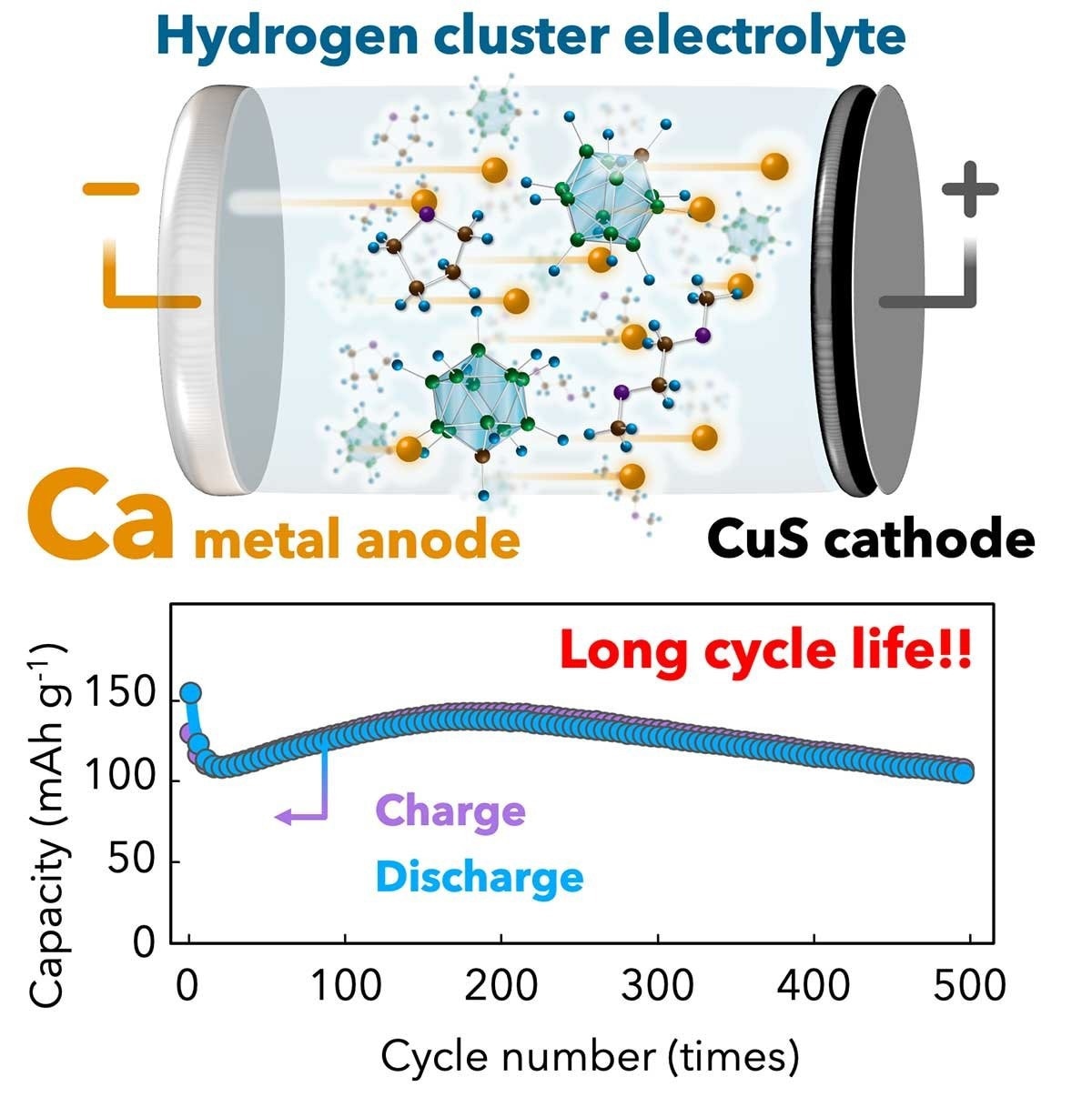A study team created a prototype calcium (Ca) metal rechargeable battery that can withstand 500 cycles of repeated charge-discharge—the practical limit.
 Schematic of a prototype Ca metal battery. The battery comprises a Ca2+ storing positive electrode containing the CuS cathode and Ca metal anode with a hydrogen cluster electrolyte. Cycling performance of the Ca-CuS battery. Image Credit: ©Kazuaki Kisu
Schematic of a prototype Ca metal battery. The battery comprises a Ca2+ storing positive electrode containing the CuS cathode and Ca metal anode with a hydrogen cluster electrolyte. Cycling performance of the Ca-CuS battery. Image Credit: ©Kazuaki Kisu
On May 19th, 2023, the breakthrough was published in the journal Advanced Science.
With the increased use of electric vehicles and grid-scale energy storage systems, there has never been a greater need to investigate alternatives to lithium-ion batteries (LIBs). Ca metal batteries are one such substitute.
Calcium, the fifth most prevalent element in the earth’s crust, is widely available and cost-effective, and it has a larger energy density potential than LIBs. Its features are also thought to aid in accelerating ion transport and diffusion in electrolytes and cathode materials, giving it an advantage over other LIB substitutes such as magnesium and zinc.
However, several barriers to the commercial feasibility of Ca metal batteries remain. The primary stumbling problems have been the lack of an effective electrolyte and the lack of cathode materials with suitable Ca2+ storing capacities.
In 2021, several members of the current research group solved the earlier problem by developing a new fluorine-free calcium (Ca) electrolyte based on a hydrogen (monocarborane) cluster. The electrolyte displayed significantly increased electrochemical performance, including high conductivity and electrochemical stability.
For our current research, we tested the long-term operation of a Ca metal battery with a copper sulfide (CuS) nanoparticle/carbon composite cathode and a hydride-based electrolyte.
Kazuaki Kisu, Assistant Professor, Institute for Materials Research, Tohoku University
CuS, a natural mineral, exhibits advantageous electrochemical properties. Because of its layered structure, it can store a wide range of cations, including lithium, sodium, and magnesium. It has a theoretical capacity of 560 mAh g-1, which is two to three times that of current cathode materials for lithium-ion batteries.
Kisu and his co-workers were able to build a cathode capable of storing huge amounts of calcium ions by using nanoparticulation and compositing with carbon materials. They provide a battery with a highly stable cycling performance when combined with a hydride-type electrolyte. Based on the capacity of the 10th cycle, the prototype battery retained 92% of its capacity after 500 cycles.
The researchers are sure that their discovery will aid the progress of research into cathode materials for Ca-based batteries.
Our study confirms the feasibility of Ca metal anodes for long-term operations, and we are hopeful the results will expedite the development of Ca metal batteries.
Kazuaki Kisu, Assistant Professor, Institute for Materials Research, Tohoku University
Journal Reference:
Kisu, K., et al. (2023) Calcium Metal Batteries with Long Cycle Life Using a Hydride-Based Electrolyte and Copper Sulfide Electrode. Advanced Science. doi.org/10.1002/advs.202301178.